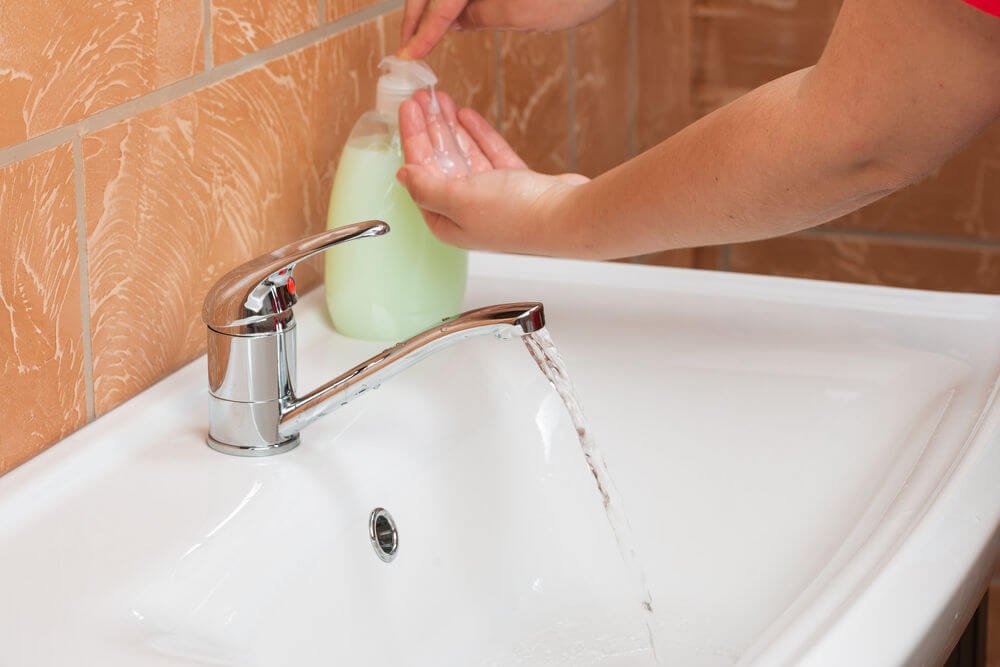Salmonellosis: What It Is and How to Prevent It

Salmonella is a type of bacteria found in the intestinal tracts of humans and animals. People can also get salmonellosis, which is an infection caused by salmonella, when they consume food contaminated with animal feces.
Meat, poultry, vegetables, milk and cheeses are very common foods that we consume in our day-to-day lives. However, they can cause us to contract salmonellosis. This bacterium disappears when food is cooked.
Symptoms of salmonellosis
The symptoms of the disease begin to appear between 12 and 72 hours after the person becomes infected. They usually disappear between 4 and 7 days later without any type of treatment. However, sometimes the disease can get complicated.
Salmonellosis can extend from the intestines into the bloodstream and other areas of the body. In this case, antibiotics would be needed for its elimination. These are the symptoms that may occur:
- Fever
- Abdominal pain
- Diarrhea
- Headache
- Shaking chills
- Sickness
- Vomiting
- Loss of appetite
- Dehydration
“Cooking meat above 140 degrees Fahrenheit ensures the elimination of salmonella.”
How to prevent salmonellosis
It’s important to make sure you cook meat and eggs before eating them. Also, don’t eat anything raw or drink unpasteurized milk. Other points that we must take into account include:

- Wash your hands with soap and clean eating utensils and preparation surfaces after handling raw meat or poultry.
- Pay attention to the food consumed by children, the elderly or people with poor immune systems.
- Wash your hands after touching reptiles or birds, even if they seem healthy. Reptile feces can sometimes contain salmonella.
- Make sure that people with poor immune systems and children don’t come into contact with reptiles.
- Don’t feed or change a baby when you’ve been in contact with raw meat.
- Keep food well chilled.
- Wash hands after touching pets.
- Avoid consuming ice unless it’s been made with potable water.
“Salmonella is a ubiquitous and resistant bacteria that can survive for several weeks in a dry environment and for several months in water.”
Treatment for salmonellosis
As we discussed earlier, this disease usually heals on its own after 4 to 7 days after the infection has been contracted. For healing purposes, it’s very important to consume large amounts of liquids.
If your symptoms persist after this time has passed, consult with your doctor for an antibiotic prescription. Don’t ever self-medicate, because some salmonella bacteria are resistant to antibiotics.
Long-term complications
Although most people usually recover from diarrhea without any problem, their bowel habits may not return to normal for a few months.

In some specific cases, they may experience joint pain, eye irritation and pain when urinating. This can last for years.
Children and the elderly require special attention
Children and the elderly are more likely to get these types of diseases because they usually have a poor immune system, which makes it easier for them to get sick. On the other hand, dehydration caused by diarrhea could put their life at risk.
If you notice your child has possible symptoms of salmonellosis that don’t disappear within one to two days, it’s best to go to the pediatrician.
If this disease reaches the bloodstream, it could infect the tissues in your child’s body and cause other serious diseases, such as meningitis, endocarditis and osteomyelitis.
There are many diseases that can be contracted through food or contact with animals, and many times we don’t even know it. That’s why it’s important to handle food properly and to always wash your hands after any contact with raw meat or eggs.
Salmonella is a type of bacteria found in the intestinal tracts of humans and animals. People can also get salmonellosis, which is an infection caused by salmonella, when they consume food contaminated with animal feces.
Meat, poultry, vegetables, milk and cheeses are very common foods that we consume in our day-to-day lives. However, they can cause us to contract salmonellosis. This bacterium disappears when food is cooked.
Symptoms of salmonellosis
The symptoms of the disease begin to appear between 12 and 72 hours after the person becomes infected. They usually disappear between 4 and 7 days later without any type of treatment. However, sometimes the disease can get complicated.
Salmonellosis can extend from the intestines into the bloodstream and other areas of the body. In this case, antibiotics would be needed for its elimination. These are the symptoms that may occur:
- Fever
- Abdominal pain
- Diarrhea
- Headache
- Shaking chills
- Sickness
- Vomiting
- Loss of appetite
- Dehydration
“Cooking meat above 140 degrees Fahrenheit ensures the elimination of salmonella.”
How to prevent salmonellosis
It’s important to make sure you cook meat and eggs before eating them. Also, don’t eat anything raw or drink unpasteurized milk. Other points that we must take into account include:

- Wash your hands with soap and clean eating utensils and preparation surfaces after handling raw meat or poultry.
- Pay attention to the food consumed by children, the elderly or people with poor immune systems.
- Wash your hands after touching reptiles or birds, even if they seem healthy. Reptile feces can sometimes contain salmonella.
- Make sure that people with poor immune systems and children don’t come into contact with reptiles.
- Don’t feed or change a baby when you’ve been in contact with raw meat.
- Keep food well chilled.
- Wash hands after touching pets.
- Avoid consuming ice unless it’s been made with potable water.
“Salmonella is a ubiquitous and resistant bacteria that can survive for several weeks in a dry environment and for several months in water.”
Treatment for salmonellosis
As we discussed earlier, this disease usually heals on its own after 4 to 7 days after the infection has been contracted. For healing purposes, it’s very important to consume large amounts of liquids.
If your symptoms persist after this time has passed, consult with your doctor for an antibiotic prescription. Don’t ever self-medicate, because some salmonella bacteria are resistant to antibiotics.
Long-term complications
Although most people usually recover from diarrhea without any problem, their bowel habits may not return to normal for a few months.

In some specific cases, they may experience joint pain, eye irritation and pain when urinating. This can last for years.
Children and the elderly require special attention
Children and the elderly are more likely to get these types of diseases because they usually have a poor immune system, which makes it easier for them to get sick. On the other hand, dehydration caused by diarrhea could put their life at risk.
If you notice your child has possible symptoms of salmonellosis that don’t disappear within one to two days, it’s best to go to the pediatrician.
If this disease reaches the bloodstream, it could infect the tissues in your child’s body and cause other serious diseases, such as meningitis, endocarditis and osteomyelitis.
There are many diseases that can be contracted through food or contact with animals, and many times we don’t even know it. That’s why it’s important to handle food properly and to always wash your hands after any contact with raw meat or eggs.
All cited sources were thoroughly reviewed by our team to ensure their quality, reliability, currency, and validity. The bibliography of this article was considered reliable and of academic or scientific accuracy.
- Turgeon P., Murray R., Nesbitt A., Hospitalizations associated with salmonellosis among seniors in Canada, 2000-2010. Epidemiol Infect, 2017. 145 (8): 1527-1534.
- Keerthirathne TP., Ross K., Fallowfield H., Whiley H., Reducing risk of salmonellosis through egg decontamination processes. Int J Environ Res Public Health, 2017.
This text is provided for informational purposes only and does not replace consultation with a professional. If in doubt, consult your specialist.








